Danh C Tran
age ~51
from Huntington Beach, CA
- Also known as:
-
- Cong Tran Danh
- Tran Danh
- Damh C Tran
- Danh Cong
Danh Tran Phones & Addresses
- Huntington Beach, CA
- Anaheim, CA
- Annapolis, MD
- 4218 Mayport Ln, Fairfax, VA 22033 • 7032631591
- Alexandria, VA
- Greenbelt, MD
- Silver Spring, MD
- Ellicott City, MD
Work
-
Position:Clerical/White Collar
Education
-
Degree:High school graduate or higher
Resumes

Danh Tran Reseda, CA
view sourceWork:
CANOGA PERKINS
Dec 2010 to 2000
Software Engineer - Network Management Software Group RAPISCAN SYSTEMS
Torrance, CA
Dec 2008 to Dec 2010
Senior Software Engineer - Baggage and Parcel Inspection Group SYMANTEC CORPORATION
Culver City, CA
Aug 2006 to Dec 2008
Senior Software Engineer - CAI - Server Security Development group SPIRENT COMMUNICATION
Calabasas, CA
Jan 2000 to Aug 2006
Software Engineer II APEX VOICE COMMUNICATION INC
Jan 1999 to Jan 2000
Software Engineer PROCAT INC
1998 to 1999
Software Engineer UCLA
Los Angeles, CA
1997 to 1998
Network & PC Technician C-ME WORLD WIDE WEB
Alhambra, CA
1996 to 1997
Computer Software Internship
Dec 2010 to 2000
Software Engineer - Network Management Software Group RAPISCAN SYSTEMS
Torrance, CA
Dec 2008 to Dec 2010
Senior Software Engineer - Baggage and Parcel Inspection Group SYMANTEC CORPORATION
Culver City, CA
Aug 2006 to Dec 2008
Senior Software Engineer - CAI - Server Security Development group SPIRENT COMMUNICATION
Calabasas, CA
Jan 2000 to Aug 2006
Software Engineer II APEX VOICE COMMUNICATION INC
Jan 1999 to Jan 2000
Software Engineer PROCAT INC
1998 to 1999
Software Engineer UCLA
Los Angeles, CA
1997 to 1998
Network & PC Technician C-ME WORLD WIDE WEB
Alhambra, CA
1996 to 1997
Computer Software Internship
Education:
University of California Los Angeles
Los Angeles, CA
1998
Bachelor of Science in Computer Science
Los Angeles, CA
1998
Bachelor of Science in Computer Science

Danh Tran Corona, CA
view sourceWork:
Lone Star College
Houston, TX
Apr 2012 to Sep 2012
Student Tutor Abercrombie & Fitch
Houston, TX
May 2012 to Aug 2012
Impact Team Member Binh Minh Restaurant
Westminster, CA
Sep 2009 to Jun 2010
Waiter
Houston, TX
Apr 2012 to Sep 2012
Student Tutor Abercrombie & Fitch
Houston, TX
May 2012 to Aug 2012
Impact Team Member Binh Minh Restaurant
Westminster, CA
Sep 2009 to Jun 2010
Waiter
Education:
Lone Star College
Houston, TX
Aug 2010 to Aug 2012
Associates Orange Coast College
Costa Mesa, CA
Aug 2009 to Jun 2010
Certificate in Business, Business Law La Quinta High School
Huntington Beach, CA
Jun 2009
High School Diploma
Houston, TX
Aug 2010 to Aug 2012
Associates Orange Coast College
Costa Mesa, CA
Aug 2009 to Jun 2010
Certificate in Business, Business Law La Quinta High School
Huntington Beach, CA
Jun 2009
High School Diploma
Name / Title
Company / Classification
Phones & Addresses
MARVELLOUS 2 FOR 1 PIZZA
Pizza
Pizza
243 Wharncliffe Road North, London, ON N6H 2B9
5198589222
5198589222
President
Infrared Fiber Systems Inc
Laboratory Analytical Instruments
Laboratory Analytical Instruments
2301 Broadbirch Dr # A, Silver Spring, MD 20904
Website: infraredfibersystems.com
Website: infraredfibersystems.com
President
Infrared Focal Systems, Inc.
Laboratory Analytical Instruments
Laboratory Analytical Instruments
2301 Broadbirch Dr Ste A, Silver Spring, MD 20904
President
Dtran Enterprise
Business Services
Business Services
9353 Bolsa Ave, Westminster, CA 92683
President
Super 1 Autobody Inc
Auto Body Repair/Painting
Auto Body Repair/Painting
3400 Westminster Ave, Santa Ana, CA 92703
7145543312
7145543312
President
Infrared Fiber Systems, Inc.
Information Technology and Services · Analytical Laboratory Instrument Mfg · Laboratory Analytical Instrume
Information Technology and Services · Analytical Laboratory Instrument Mfg · Laboratory Analytical Instrume
2301 Broadbirch Dr, Silver Spring, MD 20904
3016229546, 3016227135
3016229546, 3016227135
President
SUPER 1 AUTO BODY, INC
Auto Body Repair & Painting · Collision Services
Auto Body Repair & Painting · Collision Services
3400 Westminster Ave, Santa Ana, CA 92703
7145543312, 7145544034, 7145999900
7145543312, 7145544034, 7145999900
Vice-President
California Rice Noodle Corp
Mfg Macaroni/Spaghetti
Mfg Macaroni/Spaghetti
8350 Cerritos Ave, Stanton, CA 90680
7148219758
7148219758
Us Patents
-
Heavy-Metal Oxyfluoride Glasses For High Energy Laser Applications
view source -
US Patent:20040198581, Oct 7, 2004
-
Filed:Apr 1, 2004
-
Appl. No.:10/814193
-
Inventors:Danh Tran - Potomac MD, US
-
Assignee:Infrared Fiber Systems, Inc. - Silver Spring MD
-
International Classification:C03C003/23
C03C003/247 -
US Classification:501/043000, 501/044000
-
Abstract:Maximizing the glass forming ability of low metal-phosphate content fluoride-based glasses allows the fabrication of large-size “crystal-free” HEL windows. This involves the addition of glass stabilizer oxides such as SiO, TiO, Al2O. In situ quenching is used to fabricate large-scale HEL windows substantially free of crystals, bubbles and striation.
-
Method Of Making Optical Glass Windows Free Of Defects
view source -
US Patent:20090090135, Apr 9, 2009
-
Filed:Sep 29, 2008
-
Appl. No.:12/240525
-
Inventors:Danh C. Tran - Potomac MD, US
-
Assignee:INFRARED FOCAL SYSTEMS, INC. - Silver Spring MD
-
International Classification:C03B 19/02
-
US Classification:65 991
-
Abstract:High optical quality glass windows, particularly of low melting and low viscosity glasses and substantially free of defects, particularly adapted for high energy laser applications, are made by stirring the molten glass during cooling without the use of a mechanical stirrer within the glass, by rotating the mold or crucible in which the glass is cooling, using a motion which is not entirely a circular and rotary motion.
-
Fixation By Anion Exchange Of Toxic Materials In A Glass Matrix
view source -
US Patent:43338470, Jun 8, 1982
-
Filed:Aug 10, 1979
-
Appl. No.:6/065752
-
Inventors:Danh C. Tran - Rockville MD
Pedro B. Macedo - Bethesda MD
Joseph H. Simmons - Bethesda MD
Catherine J. Simmons - Bethesda MD
Nicholas Lagakos - Silver Spring MD -
International Classification:G21F 916
-
US Classification:252629
-
Abstract:This invention relates to the immobilization of toxic, e. g. , radioactive materials, internally in a silicate glass or silica gel matrix for extremely long periods of time. Toxic materials, such as radioactive wastes containing radioactive anions, and in some cases cations, which may be in the form of liquids, or solids dissolved or dispersed in liquids or gases, are internally incorporated into a glass matrix, having hydrous organofunctionalsiloxy groups, e. g. , hydrous aminoalkylsiloxy or carboxyorganosiloxy, bonded to silicon atoms of said glass and/or hydrous polyvalent metals bonded to silicon atoms of said glass through divalent oxygen linkages or otherwise immobilized therein, by a process which involves the ion exchange of said toxic, radioactive anions with hydroxyl groups attached to said organofunctionalsiloxy groups or with hydroxyl groups attached to the hydrous polyvalent metal. Thereafter, the resulting glass now characterized by a distribution of internally bonded or immobilized, toxic, radioactive anions can be packaged in suitable containers, and disposed of as by burial, and/or they can be sintered to collapse the pores thereof prior to disposal or for producing useful radiation sources. The porous glass or a porous silica gel having said silicon-bonded organofunctionalsiloxy groups and/or said hydrous polyvalent metal oxy groups, the pores of said glass or silica gel remaining open and uncollapsed, can be used advantageously as a backfill for an underground radioactive waste burial site and as overpack in the waste disposal container.
-
Fluoride Glass Fibers With Reduced Defects
view source -
US Patent:50551205, Oct 8, 1991
-
Filed:Mar 20, 1990
-
Appl. No.:7/498453
-
Inventors:Danh C. Tran - Bethesda MD
Reza Mossadegh - Silver Spring MD
Nicholas Garito - Fairfax VA
Mohamad Farid - Silver Spring MD -
Assignee:Infrared Fiber Systems, Inc. - Silver Spring MD
-
International Classification:C03B 37027
C03B 37012 -
US Classification:65 311
-
Abstract:Improved fluoride glass optical fibers are produced by a process introducing several improvements in the production of fluoride glass preforms and the drawing of fibers therefrom. Reduced bubble formation and crystallization are obtained by vertically spinning a fluoride glass melt within a glass cladding tube at a high rotational speed, or alternatively, pouring a flouride glass core melt into a cladding tube while slowly raising the mold from an inclined position to a vertical position, or alternatively, introducing a core tube inside a cladding tube. The production of fibers is enhanced if at least one production phase, i. e. , preform formation or fiber drawing, is conducted in an atmosphere containing reactive gases that scavenge molecules that could otherwise react with, hydrolyze and oxidize the fluoride glass. The disclosure also describes several devices uniquely useful in the process of the present invention. In another aspect of the present invention, fluoride glass fibers may be clad with a fluoropolymer which is coated with a polymerizable resin.
-
Biocompatible Optical Fiber Tip For In Vivo Laser Surgery
view source -
US Patent:58091998, Sep 15, 1998
-
Filed:Sep 20, 1996
-
Appl. No.:8/717099
-
Inventors:Danh Tran - Bethesda MD
-
Assignee:Infrared Fiber Systems, Inc. - Silver Spring MD
-
International Classification:G02B 600
-
US Classification:385141
-
Abstract:A biocompatible optical fiber tip derived from fluorophosphate glasses whose composition includes P--O compounds, AlF. sub. 3, alkali-earth fluorides, and/or alkali fluorides, and lanthanides fluoride is used with a medical laser to transmit power for surgical applications.
-
Immobilization Of Radwastes In Glass Containers And Products Formed Thereby
view source -
US Patent:43127746, Jan 26, 1982
-
Filed:Apr 30, 1979
-
Appl. No.:6/034567
-
Inventors:Pedro B. Macedo - Bethesda MD
Catherine J. Simmons - Bethesda MD
Danh C. Tran - Rockville MD
Nicholas Lagakos - Silver Spring MD
Joseph Simmons - Bethesda MD -
International Classification:G21F 916
-
US Classification:252629
-
Abstract:This invention relates to the immobilization of toxic materials, e. g. , radioactive materials, in glass for extremely long periods of time. Toxic materials, such as radioactive wastes, which may be in the form of liquids, or solids dissolved or dispersed in liquids or gases, are deposited in a glass container which is heated to evaporate off non-radioactive volatile materials, if present; to decompose salts, such as nitrates, if any, and to drive off volatile non-radioactive decomposition products, and then to collapse the walls of said container on said radwaste and seal the container and immobilize the contained radwaste, and then burying the resulting product underground or at sea. In another embodiment, the glass container also contains glass particles, e. g. , spheres or granules, on which the radwaste solids are deposited.
-
In-Situ Quenched Fluoride Glasses
view source -
US Patent:50455079, Sep 3, 1991
-
Filed:Jan 22, 1990
-
Appl. No.:7/468300
-
Inventors:Danh Tran - Bethesda MD
-
Assignee:Infrared Fiber Systems, Inc. - Silver Spring MD
-
International Classification:C03C 332
-
US Classification:501 40
-
Abstract:A process for producing high quality optical glass from fluoride glasses comprising preparing a melt of the glass and then cooling the melt in-situ inside the melt crucible. The in-situ quenching technique can be improved by narrowing the temperature range between the liquidus temperature and the glass transition temperature of the glass. The stability of the fluoride glass can be increased and the liquidus temperature of the glass can be lowered by doping the glass with a chloride dopant. Thorium tetrafluoride can be added to the chloride-doped glass in order to increase the chemical stability of the glass.
-
High-Strength Fluoride Glass Fibers And Process Of Making
view source -
US Patent:48987778, Feb 6, 1990
-
Filed:Jan 24, 1989
-
Appl. No.:7/300852
-
Inventors:Edwin A. Kindler - Takoma Park MD
Danh C. Tran - Bethesda MD -
Assignee:Infrared Fiber Systems - Silver Spring MD
-
International Classification:C03C 1500
-
US Classification:428364
-
Abstract:A novel solution of H. sub. 3 BO. sub. 3 dissolved in strong hydrochloric or nitric acid is used to etch fluoride glass preforms used to manufacture fluoride glass fibers. Because of the excellent cleaning ability of the present solution, as well as the absence of sub-micron deposits, the resulting fibers have excellent bending strength.

Danh Tran
view source
Danh Tran
view source
Duc Danh Tran
view source
Danh Tran
view source
Danh Tran
view source
Danh Tran
view source
Danh du Tran
view source
Danh Nguyen Tran
view sourceFlickr
Googleplus

Danh Tran
Work:
Hanoi,Vietnam - Executive Chef
Education:
Thot Not,Can Tho

Danh Tran
Work:
Tram y te trung hung - Y si da khoa

Danh Tran
Work:
Dong nai
Tagline:
Tinh tinh vui ve,thich duoc tu do khong go bo va co nhiu ban de vui choi

Danh Tran

Danh Tran

Danh Tran

Danh Tran

Danh Tran
Classmates

Danh Tran
view sourceSchools:
Ethan B. Allen Elementary School Fountain Valley CA 1999-2003
Community:
Amy Fortenberry

Danh Tran
view sourceSchools:
Petrus Ky High School Saigon Viet Nam 1965-1969

Danh Tran, Ft. Collins Hi...
view source
Ethan B. Allen Elementary...
view sourceGraduates:
Lisa Hughes (1980-1988),
Anthony Lowry (1999-2003),
Danh Tran (1999-2003),
Amie Shapiro (1993-1997),
Donna Bertram (1978-1984)
Anthony Lowry (1999-2003),
Danh Tran (1999-2003),
Amie Shapiro (1993-1997),
Donna Bertram (1978-1984)

Westminster High School, ...
view sourceGraduates:
Steve Goldstein (1969-1973),
danh tran (1988-1992),
ROBERT WATKINS (1957-1961),
Michele Solomon (1963-1967)
danh tran (1988-1992),
ROBERT WATKINS (1957-1961),
Michele Solomon (1963-1967)

Yadkinville High School, ...
view sourceGraduates:
Danh Tran (1999-2003),
James Wooten (1959-1963),
Eugene Swaim (1956-1960)
James Wooten (1959-1963),
Eugene Swaim (1956-1960)

South High School, Worces...
view sourceGraduates:
danh tran (1995-1999),
deborah cross (1971-1975),
Jason Harthan (1992-1996),
Wendi Grant (1977-1981),
John Bourassa (1963-1967)
deborah cross (1971-1975),
Jason Harthan (1992-1996),
Wendi Grant (1977-1981),
John Bourassa (1963-1967)

Treasure Island Elementar...
view sourceGraduates:
Danh Phat Tran (1987-1992),
Ashley Kearns (1976-1979),
Shannon Lawrence (1979-1981),
David Goad (1990-1993)
Ashley Kearns (1976-1979),
Shannon Lawrence (1979-1981),
David Goad (1990-1993)
Youtube
Get Report for Danh C Tran from Huntington Beach, CA, age ~51













